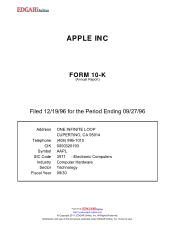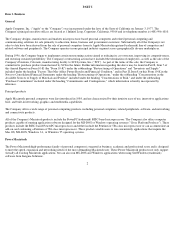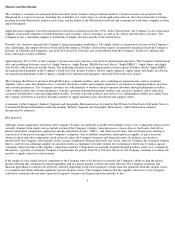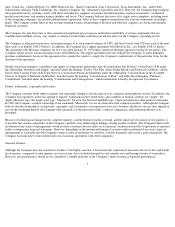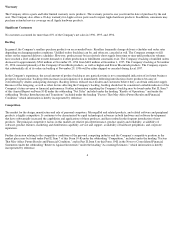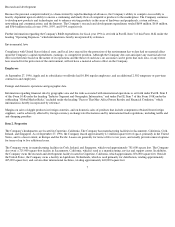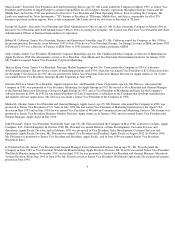Apple 1996 Annual Report Download - page 7
Download and view the complete annual report
Please find page 7 of the 1996 Apple annual report below. You can navigate through the pages in the report by either clicking on the pages listed below, or by using the keyword search tool below to find specific information within the annual report.time: Canon, Inc., General Electric Co., IBM, Motorola, Inc., Sharp Corporation, Sony Corporation, Texas Instruments, Inc., and/or their
United States affiliates VLSI Technology, Inc., Quanta Computer, Inc., Quantum Corporation, and SCI. However, the Company helps mitigate
these potential risks by working closely with these and other key suppliers on product introduction plans, strategic inventories, coordinated
product introductions, and manufacturing schedules and levels. The Company believes that most of its single-source suppliers, including most
of the foregoing companies, are reliable multinational corporations. Most of these suppliers manufacture the relevant components in multiple
plants. The Company further believes that its long-standing business relationships with these and other key suppliers are strong and mutually
beneficial in nature.
The Company has also from time to time experienced significant price increases and limited availability of certain components that are
available from multiple sources. Any similar occurrences in the future could have an adverse affect on the Company's operating results.
The Company is obligated to purchase certain percentages of its total annual volumes of CPUs and logic boards from SCI over each of the next
three years (see Exhibit 10.B.14 hereto). In addition, the Company has a supply agreement with Motorola, Inc. (see Exhibit 10.B.12 hereto).
The agreement with Motorola continues for five years from January 31, 1992 unless otherwise mutually agreed in writing by the parties. The
Company single-sources certain microprocessors from Motorola. The supply agreement does not obligate the Company to make minimum
purchase commitments; however, the agreement does commit the vendor to supply the Company's requirements of the particular items for the
duration of the agreement.
Further discussion relating to availability and supply of components and product may be found under Part II, Item 7 of this Form 10-K under
the subheading "Inventory and Supply" included under the heading "Factors That May Affect Future Results and Financial Condition," and in
Part II, Item 8 on this Form 10-K in the Notes to Consolidated Financial Statements under the subheading "Concentrations in the Available
Sources of Supply of Materials and Product" included under the heading "Concentrations of Risk," and under the subheading "Purchase
Commitment" included under the heading "Commitments and Contingencies," which information is hereby incorporated by reference.
Patents, trademarks, copyrights and licenses
The Company currently holds rights to patents and copyrights relating to certain aspects of its computer and peripheral systems. In addition, the
Company has registered, and/or has applied to register, trademarks in the United States and a number of foreign countries for "Apple", the
Apple silhouette logo, the Apple color logo, "Macintosh", Newton, the Newton Lightbulb logo, Claris and numerous other product trademarks.
In 1986, the Company acquired ownership of the trademark "Macintosh" for use in connection with computer products. Although the Company
believes that the ownership of such patents, copyrights, and trademarks is an important factor in its business and that its success does depend in
part on the ownership thereof, the Company relies primarily on the innovative skills, technical competence, and marketing abilities of its
personnel.
Because of technological changes in the computer industry, current extensive patent coverage, and the rapid rate of issuance of new patents, it
is possible that certain components of the Company's products may unknowingly infringe existing patents of others. The Company believes the
resolution of any claim of infringements would not have a material adverse effect on its financial condition and results of operations as reported
in the accompanying financial statements. However, depending on the amount and timing of an unfavorable resolution of any such claims of
infringement, it is possible that the Company's future results of operations or cash flow could be materially affected in a particular period. The
Company has from time to time entered into cross-licensing agreements with other companies.
Seasonal business
Although the Company does not consider its business to be highly seasonal, it has historically experienced increased sales in its first and fourth
fiscal quarters, compared to other quarters in its fiscal year, due to holiday demand for and calendar year-end buying of some of its products.
However, past performance should not be considered a reliable indicator of the Company's future revenue or financial performance.
5

